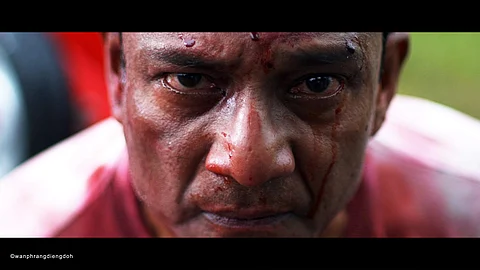

The image that sticks with you after watching the trailer of Lorni – The Flaneur (meaning, 'an inquisitive person' in the Khasi language) is that of critically-acclaimed actor Adil Hussain zipping along the streets of Shillong in his red scooter, clad in a leather jacket with a cross-body bag slung across his chest. But after watching the nearly one-and-a-half-hour movie, the image you will be left with is that of the same actor smeared in blood, breathing fire through his angry red eyes. Now, how the actor's character - the self-styled detective Shem - goes from the first image to the second is what signifies his journey in this movie directed by Wanphrang Diengdoh. An intriguing story, to say the least, of a man in search of an object of 'great cultural value' to the Khasi tribe (an indigenous ethnic group), he finds much more than he bargained for on his quest.
After completing his MA in Mass Communication from Jamia Millia Islamia in 2009, Wanphrang went on to make a slew of documentary and non-fiction movies including Where the Clouds End, a documentary he made in 2014 on indigenous identity and border politics. Then there was Because We Did Not Choose, a 92-minute documentary on World War I, shot in France, Wales, England and India that took him four years to complete. The 35-year-old felt that he needed a break from those types of movies. "I looked at the scripts I had written over the last ten years and Lorni seemed most appealing to me. Of course, the script had to be tweaked because a lot has changed in Shillong over the years," says the director who was born and brought up in 'The Abode of Clouds'.
He approached none other than actor Adil Hussain who was born in Goalpara, Assam - thus ensuring strong Northeastern roots - so that the ace artist could help train the mostly first-time actors for the movie. But Adil ended up playing the lead because he was smitten by the script. While Adil had 15 days to spare from his busy schedule, it took 24 days to shoot the entire film which they started shooting in July 2018.
Those who are familiar with the director's work know that music is as essential an element to him as anything else in a movie. “We went ahead and even made a music video for the film," laughs Wanphrang (fondly known as Wan), adding that Tarik, the politico-punk band that he is a part of, was responsible for the music video. Talking about the Khasi elements in the story, the director tells us that the story is as much about the folklore of the Khasi tribe as it is about the indigenous tribe transitioning into modernity, "and in this process, answer the question of how much of our tribal identity we should give up and how much of modernity we should embrace. Since I am also from the Khasi tribe, I feel fortunate that I can chronicle this transitional phase."
Stills from the movie
The challenges they faced while shooting:
- As there were no studios in Shillong to carry out their post-production work, they had to do it in Mumbai
- The director was very particular about the colouring of the film and also the sound design, so time and effort were spent on getting it right
